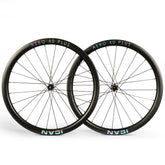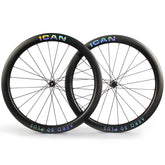Fat Bike Buying Guide 2024
Fat bikes have experienced a boom, but their sales are rising again. The reason more and more people want fat bikes is because they are fun. After a ride on a fat bike, you can't help but put on a big grin. If you want a hassle-free bike that you can ride in any weather, then a fat bike is for you.
In this article, we will write down all the details about the fat bike. Everything you need to know about the parts a fat bike comes with. You will know why you should choose a fat bike to avoid further mistakes.
quick start Guide
- The difference between a fat bike and a mountain bike
- How to choose a fat bike
- How to choose a fat bike frame
- How to Choose Fat Bike Wheels
- How to choose a fat bike fork
- How to choose a fat bike group
- How to Choose Fat Bike Components
What is the difference between a fat bike and a mountain bike?
The simple answer is that a fat bike has thicker tires than a regular mountain bike. However, this simple answer ignores a whole bunch of subtleties. Fatbike tires are generally considered to be tires with a width greater than 3.8". To accommodate tires of this width, the frame and forks must be modified. Rims and hubs must be much wider to accommodate such wide tires. That's why that the wheels need to be stiffer to support the additional tire weight.

ICAN SN04 Fat Bike
The size of the quick release axle varies
The original fat bikes have a standard 135mm rear triangle with a quick release axle. As the market expanded, new hub and axle standards emerged. Generally, the rear hub of a fat bike is now 170mm or 197mm wide.
The rims of a mountain bike have a standard width of 21 mm. On fat bikes, the rim width has been increased to 90mm, and this additional width is needed if you want to fit 5" wide tires. The rear ends had to become longer to accommodate these tires, rims and wider hubs.
These longer rear ends make fat bikes feel more stable when you're riding over rough terrain or even pushing hard on a downhill section. The change in the rear triangle also led to a change in the bottom bracket area.
The bottom bracket shell had to be wider to give the stays clearance and keep them stiff. Fat bike bottom brackets have grown from 73mm wide to 100mm wide, and now some are even 120mm wide.

Fat bike fork size is different
The forks also have to go through this process. A standard mountain bike front hub is 100mm wide. Fat bikes have had their width increased to 135mm, and now they are also available in 150mm width. These changes in width make a fat bike feel much stiffer than first impressions might suggest. If you ride a fat bike, you'll probably find that the geometry isn't as slack as a modern trail bike. The reason for this is that a fat bike isn't just about zipping downhill. You may also have to cross moors, swamps, snow or sand. A limp bike would be less fun in these environments.
How to choose the fat bike well
When choosing the best fat bike suitable for you, you should focus on all the factors below.- Weight
- Areas of application
- Price
- What size fat bike do you want
Weight
It is unavoidable that a fat bike is heavier than a normal mountain bike. The extra width of the parts adds to the weight of the bike. Many fat bikes are made from steel and some from aluminum. Steel is the heaviest, but it looks good to a lot of people. Aluminum is lighter but more susceptible to failure under repeated impacts.
That's why we built our fat bikes out of carbon fiber. A carbon fiber fat bike can be much lighter than expected. Plus, it has a great ride, and carbon can last almost indefinitely - a great way to protect the value of your purchase.
Scenarios to use
The same applies to most types of bicycles: it's worth considering how you'll ride the bike. There is no reason to buy a full suspension fat bike if all you want to do is ride on the beach. If you want to ride on the beach, in the snow, and in the other traditional areas where fat bikes are used, check out our Black Knight or Golden Knight models.

The Black Knight and Golden Knight models are 2 examples of classic fat bikes that roll to you straight from the factory. These 2 models will help you prepare for bikepacking, and the more you ride them, the more you'll see that they're more than capable of tackling all terrains. Check out the upgraded Black Knight model if you want to ride a fat bike with a hint of trail. The Black Knight Pro is equipped with a Rock Shox Bluto fork that allows you to go faster on descents while still being able to pedal well on uphill sections.
If you want to go even faster, we have a true full suspension trail fat bike based on our SN04 frameset . Our full suspension fat bike allows you to go downhill faster than you could have ever imagined on a fat bike. However, you can also use it to traverse terrain that other full-suspension mountain bikes cannot handle.
Fat bike price
Because fat bikes don't use mass-produced goods, prices for fat bike parts are typically higher than regular mountain bike parts. At ICAN, we've worked hard to keep our fat bike specific parts affordable. Although our parts are made from high quality carbon that we ship directly to you, our prices are comparable to many entry-level steel and aluminum parts from other brands.
We've also leveraged our phenomenal carbon experience to ensure you're paying for the qualities you need in carbon parts, not gimmicks. Our pieces exceed everything they do and should leave you with a pleasantly filled wallet too.
What size fat bike do you need?
Fat bike sizing works pretty similarly to mountain bike sizing. Let's say you're planning on bikepacking or larger excursions and you're on the verge of becoming a size. In this case I would recommend increasing the size, unlike normal bikes where I would recommend decreasing the size.
The extra length gives you more space for bags and luggage and also brings you more stability. After a long day in the saddle or on a multi-day tour, a little extra stability is not something to sneeze at. A bike that wants to keep you upright can be a godsend.
How to choose a fat bike frame
Weight of the frame
When you think about building a fat bike, you think about the weight and how you can save it. One of the most obvious decisions for most people is to purchase an aluminum fat bike frame. An aluminum frame seems to be the cheapest way to save weight.
Most people don't realize that our high-end carbon frames cost similar to most companies' mid-range aluminum fat bike frames.
It is generally believed that aluminum has a lifespan of 5 years before breaking. We all know someone with an aluminum frame who has lived longer, but that's the average lifespan you expect. The lifespan of a carbon fat bike frame is now considered infinite.
As we mentioned earlier, fat bikes use parts that can be very different than those used on standard mountain bikes. So if you are planning to build your custom fat bike, you need to make sure that all the parts you want to have work together and fit together.
Hardtail or full suspension fat bike frame ?
You should choose a frame that fits most of your rides. If you spend most of your time on trails, we recommend a full-suspension fat bike. This makes going downhill more fun and you don't have to worry about falling when going downhill.
You should also keep in mind that the tires offer good suspension travel and rebound. So you don't need to look for 140mm of rear wheel travel like you might on a trail bike. You should also take extra time to properly set up your bike so that you have one of the best fat bike experiences money can buy.
If you want to adventure far and wide or ride on beaches, swamps, and snow, we recommend a hardtail fat bike. The hardtail allows you to maintain a good pedal stroke and sail over the worst terrain. You can add a suspension fork if you're up for some mid-trail action.
Distance at the back
Let's say you are planning to purchase a frame to replace an existing frame. You need to consider how wide your rear wheels are as we have already mentioned most fat bikes. Most wheels are 177mm, 190mm or 197mm wide. All our frames fit a 197mm hub to give your bike maximum tire clearance.
Fat bike frame size
As we mentioned before, fat bike customization can be a little subjective. Let's say you're riding our full suspension frame. In this case, we recommend checking the standover to avoid unnecessary injuries if you jump off the bike during a descent. The standard advice, if you're at the limit of a size, take the smaller size and make it bigger, is what we would follow.
If you ride a hardtail and want a sturdy frame, you should go as big as possible. This gives you stability and comfort for many hours on the bike. However, you should still make sure that you have enough ground clearance.
Which fat bike wheels do you need?
Most fat bike wheels are equipped with an aluminum rim. Aluminum is one of the most popular materials in the bicycle industry for making rims. Aluminum rims are easy and cheap to manufacture. However, it is more difficult to integrate all the desired features into aluminum rims.
There is a material that can be used to incorporate all the desired properties into a rim. Carbon fiber allows engineers to build super strong and stiff rims. There is another advantage of this method. It allows us to build a lightweight rim. Buy carbon fat bike wheels here.
Lighter wheelsets are something that all fat bike owners want, and thanks to our construction processes and the fact that we sell directly to you, you can get carbon wheelsets at a very affordable price.

Width of the fat bike rim
The wider the rim, the wider tires you can fit. This also depends on whether your frame can accommodate the tire width. We offer 2 fat bike rim widths. 65mm or 90mm. 90mm is ideal for tires up to 45.0" wide.
Wide tires on our rims allow you to glide over swampy, snowy or sandy terrain. These are the tires for winter driving or driving in inhospitable areas. In summer you should install 65mm rims and use a narrow tire. This will save you some weight and make your fat bike feel like a plus bike.
If you want that plus bike feel in the summer, try fat bike hubs on 27.5"+ or 29"+ rims. You now have 2 bikes for the price of an additional set of wheels and tires.

Go tubeless
Our fat bike rims are tubeless-capable. Going tubeless is a great idea for a fat bike. Changing a tube and inflating a fat bike tire is no fun on the trail. It may even be more strenuous than the ride you are currently doing. A tubeless tire also allows you to ride at lower tire pressures, which is even more important on a fat bike than on a regular mountain bike.
Fat bike tires and air pressure
Fat bike tires now come in a variety of styles. There are solid tires for muddy conditions and smooth tread tires for those who like to ride their fat bikes in urban environments.
Tire choice can be very subjective, and if you prefer a particular brand, you can extend that preference to their fat bike range. The more expensive a tire is, the lighter it should be and the easier it should be to mount it tubeless.
Tire pressure can also be subjective. However, you should keep in mind that fat bike tires can slightly change the way your bike handles due to their width, and the higher the pressure, the more you will feel like the tire is bouncing off you. In general, you need to adjust tire pressure depending on your weight and driving style.
For driving on soft surfaces, we recommend a tire pressure of 8 PSI. For general trail riding, the pressure is 12-15 PSI. For city riding, you should choose a pressure of 20-25 PSI. At higher pressures, you need to be aware that your fat bike may develop some self-consciousness. So experiment with the pressure and see how you get on.
Hub size for fat bikes
We already talked about the size of the rear wheel hub in the section about the frame. Don't forget that you also need to know what hub size and style your front wheel is. Depending on the hub width, there are different thru axle and quick release options.
We use the 150x 15mm front wheel with thru axle. You need to make sure your current fork fits this, or check out our rigid carbon fat bike fork. Rear axle width: We offer widths and options for thru axles and quick releases. Make sure you choose the right model for your frame and if you need help, please contact us.

How to choose a fat bike fork
Fat bikes usually come with a rigid fork or a suspension fork. Rigid forks haven't disappeared from fat bikes to the same extent as they have from regular mountain bikes, for two reasons. The first reason is that many people don't see the need for a suspension fork due to the suspension provided by the tires. The second reason is that a suspension fork adds extra weight when you don't need it.
However, if you like going downhill, you should try a suspension fork. The fork keeps the bike in contact with the ground, taking some of the strain off your wrists on the toughest trails.
Hub width
As mentioned above, you need to make sure your front wheel fits into your fork. Fat bike wheels usually come with a 135mm or 150mm wide front hub. The 150mm front hub is preferred by most manufacturers and allows for easy switching between rigid and suspension forks. We offer 135mm and 150mm carbon forks to meet your needs.
Which travel for your fork?
Fatbike tires are generally expected to have 30mm of travel, and this is something to keep in mind when purchasing a suspension fork for your fatbike. A fork with 120mm travel will give you 130mm of travel, which will be more than enough for most trails. With the grip that the tires provide and the tracking of a 120mm fork, you'll find that crashing is something you have to do instead of spending your time trying to avoid crashing.
How to choose a fat bike group
Choosing a groupset is generally the same as for a regular mountain bike. If you prefer SRAM, buy SRAM. If you prefer Shimano, buy Shimano. With a modern 1x system you still have a wide range of gears, but it prevents mud and dirt from settling in the bottom bracket.
A rear derailleur with a clutch is very helpful on a fat bike. It's natural that you'll be doing a lot of unforgiving terrain, and any feature that helps protect your chain is worth the money. SRAM's Type 2 rear derailleurs have a clutch, so you'll want to look for a Shadow Plus rear derailleur from Shimano.
How to Choose Fat Bike Components
When it comes to components, it also depends on what you subjectively think about certain parts. We find that carbon parts further reduce weight and provide a great riding experience on fat bikes. If you don't want a seat post, a carbon post can help eliminate certain vibrations before they become noticeable and add a bit of flexibility to the system for added comfort.
A carbon handlebar also prevents the vibrations from tiring your wrists and arms. Combine this with a carbon stem and you get a very light cockpit with excellent steering control.
Conclusion
With a little thought, it's possible to build a carbon fat bike that's light enough for racing. In fact, you'll find many people using them in endurance events, not just fatbike-specific events.
By making your bike light and pairing it with big, fat tires, you'll find a bike that rewards you greatly no matter where you ride it. Is it time to upgrade your fat bike with carbon fiber parts?






